LED Projectors
Choosing the right LED projector for you.
What brightness level do I require?
What Resolution is right for me?
Are the pocket projectors any good?
What does the PC Free and Wireless features mean?
Is there anything else to look for?
What LED projectors do you recommend?
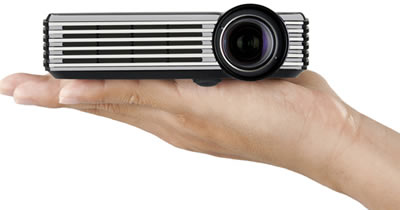
Long Life - LED projectors offer a longer lifespan than the lamp based counterparts. While an average lamp life is up to 3,000-10,000 hours, LED projectors feature a light source life up to 30,000 hours. The catch? Once the LED has failed you generally cannot replace it like with a lamp, however, the led light life span is normally longer than the average life of a projector anyway.
Portability - LED Projectors tend to be much smaller and more portable than their lamp based counterparts though generally significantly less bright.
Media Players - Many LED based projectors can operate without a PC or other player connected and can read many file types from a memory stick. Perfect for 'on the road' presentations to small groups.

Brightness with all the major projector brands is universally measured in ANSI Lumens. Traditionally the brightness level for LED projectors ranges from 50 to 2000 ANSI Lumens. While some of the Laser & LED Hybrid projectors are a much more powerful at up to 4000 lumens.
Your viewing environment and audience size will be a major factor in determining how bright your
projector must be. Below is a basic recommendation of required brightness level:
Personal presentations to 2-4 people = 250 Lumens
Small Group of 6-12 People = 500-750 Lumens
Class/Meeting Room up to 20 people = 1000 Lumens
Room lighting conditions will also play a factor. In a standard sized meeting room (ie approx 20
people with lights on), a brightness level of 2500 Lumens or more is recommended. A lower brightness
can still be used, however the ambient light in the room may have to be lowered to ensure a clear
image. For large rooms you will be best to consider a lamp or laser based projector rather than LED.
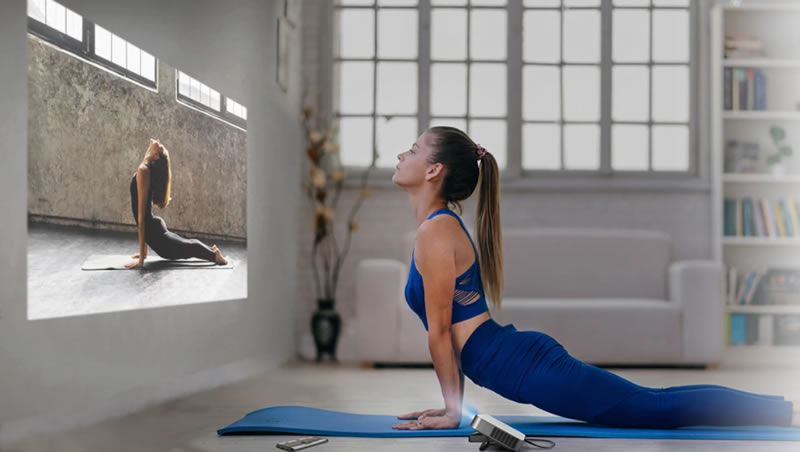
A resolution is essentially a measurement for the number of pixels being projected. Usually this is represented in a number of pixels width to height e.g. 1920 pixels width and 1080 pixels high. Projectors may accept signals higher and lower of the native resolution but will have to convert or compress the signal to display in the native resolution.
The most common measurements in led projectors are
- SVGA - 800x600 - For basic PowerPoint presentations with large font sizes. Is slowly being phased out.
- XGA - 1024x768 - Great for basic Powerpoint and video presentations. Also being phased out.
- FWVGA - 854 x 480 (SD)- Being widescreen this is great for SD Video's, It is common in the entry level led projectors.
- WXGA - 1280x800 (HD) - Enough detail to handle smaller text or HD video e.g. Excel Spread Sheets
- WUXGA - 1920 x 1080 or 1920 x 1200 (FULL HD) - Great detail, perfect for all presentations and high quality video's
The WXGA or FULL HD resolutions are always to the recommended resolutions within the LED category. Many very small LED projectors tend to use a low resolution so always check the advertised 'native resolution' before purchasing.
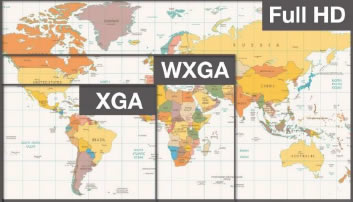
With advancing technology, LED projectors are now smaller and more portable than ever before. Many new projectors weigh in at only 300grams and are palm sized. The small the projector is, however, normally means less power... the slightly larger and heavier units usually will give a brighter image. Always compare both the native resolution and the brightness when selecting your projector. Also keep in mind some brands do not use ANSI Lumens, they may use 'LED Lumens' or simply 'Lumens', which can make it difficult to compare 'Apples with Apples'. As with most things you get what you pay for so keep that in mind if you see a really cheap projector being advertised on the Socials or an online Marketplace.
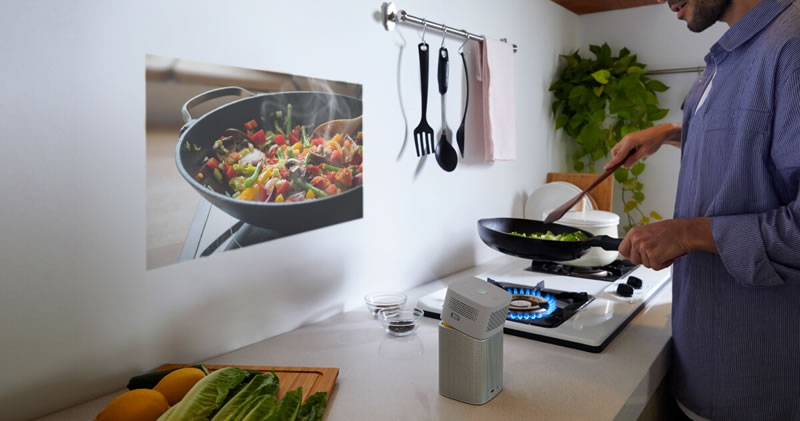
PC Free and Wireless functions are 2 relatively new technologies to be found on LED projectors. PC Free allows the unit to project a presentation, image or some video files without the need to connect a computer or any other AV device. Compatible files can be loaded onto a USB flash drive, or SD Card, which is then connected directly to the projector. The projectors can only read some file types so if you need to project a particular file type always check the projector specifications prior to purchase or ask one of our staff. PC Free is a great option for professionals that have many meetings or presentations a day and do not wish to carry around both a projector and a notebook computer.
Wireless connectivity allows the projector to connect to a computer without the need for cabling. A wireless connection can be a little slower than a cable so whilst it's great for pictures and powerpoints, video may not appear very smooth.
Before you begin your search for a projector, it is important to know exactly what you wish to use your projector for. Are you planning on using it solely for presentations? Or will you be taking it home in the evenings for some home movies? This can become a factor especially as some projectors will offer better inbuilt speakers or media players if you intend for it to be a home entertainment unit as well. Sometimes going for that slightly more expensive unit will give you far more usability and allow you to enjoy your projector more often.
Unfortunately the projector industry has been flooded with cheap no-name projectors, mainly sold
through online marketplaces and social media. Many of these items do not meet Australian electrical
safety standards and tend to significantly overstate the specifications of the unit. Always purchase
your projector from a reputable store and purchase a well known brand. Remember reviews and positive
comments on social media can be faked so do your research.
LED stands for 'Light Emitting Diode' but there are some no name brands popping up selling very low
quality lamp projectors labelled as LED that they define as 'Light Emitting Device'. So how do you
identify these? If it looks to good to be true it probably is. Stick with real brands that have
parts, service centres, and above all, Australian warranties. It is simply not worth the risk.
The team at Just Projectors are constantly testing new releases to determine the best projectors available for the money. Below we list a range of LED based projectors we recommend you consider. As always if you have any queries feel free to get in contact with us.
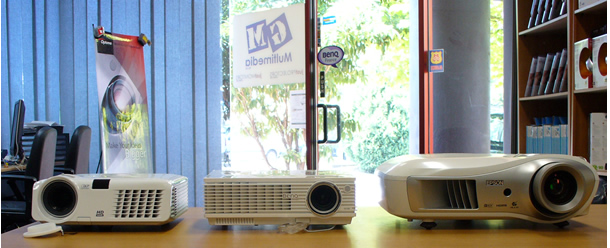
Wanbo Dali 1
720p HD LED
Entertainment Projector
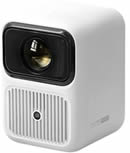
- Bonus Wanbo Tote Bag
- 350 ANSI Lumens
- 0.9kg Weight
- Android 9.0 Inbuilt
- Wireless Streaming
- Bluetooth Audio 5.0
- 2x 5W Speakers
- Optional Bag
Wanbo X2 Max
1080p Full HD LED
Entertainment Projector

- Bonus Wanbo Tote Bag
- 450 ANSI Lumens
- 1.5kg Weight
- Android 9.0 Inbuilt
- Wireless Streaming
- Bluetooth Audio 5.0
- 2x 3W Speakers
- Opt. Bag
Wanbo DaVinci 1 Pro
1080p Full HD LED
Entertainment Projector

- Free Delivery!
- 600 ANSI Lumens
- 2.8kg Weight
- Android 11.0 Inbuilt
- Wireless Streaming
- Bluetooth Audio 5.0
- 2x 8W Speakers
Wanbo Mozart 1 Pro
2025 Edition 1080p LED
Entertainment Projector

- Free Delivery!
- 1200 ANSI Lumens
- 90% DCI-P3 Colour
- Premium Bass Woofer
- 4K & HDR Compatible
- 4K App Support
- 3.3kg Weight
- Android 11.0 Inbuilt
- Wireless Streaming
- Bluetooth Audio 5.0
BenQ X500i
2160p 4K LED
S/Throw Home Projector

- 2200 ANSI Lumens
- 600,000:1 Contrast
- Fast Gaming Mode
- Android 11 Inbuilt
BenQ X3100i
2160p 4K LED
Home Projector
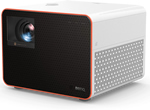
- 3300 ANSI Lumens
- 600,000:1 Contrast
- 100% DCI-P3 Colour
- Fast Gaming Mode
- Android 11 Inbuilt